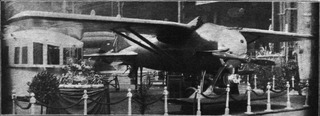Related Research Articles

Grigorovich M-5 was a successful Russian World War I-era two-bay unequal-span biplane flying boat with a single step hull, designed by Grigorovich. It was the first mass production flying boat built in Russia.

Grigorovich M-15 was a successful Russian World War I-era biplane flying boat, developed from the M-9 by Grigorovich.
Grigorovich M-16 was a successful Russian World War I-era biplane flying boat of the Farman type, developed from the M-9 by Grigorovich. Somewhat larger than the M-9, the M-16 was a version especially intended for winter operations, with better aerodynamic qualities.

The Grigorovich M-11 was a Russian single-seat fighter flying boat designed by Dmitry Pavlovich Grigorovich and built by Shchetinin

Polikarpov DI-1, also known as 2I-N1, Russian: Поликарпов ДИ-1 (2И-Н1), was a prototype Soviet two-seat fighter designed during the 1920s. The sole prototype built crashed on its ninth flight, due to manufacturing defects, and the program was cancelled.

Grigorovich DI-3, , was a prototype two-seat fighter developed in the Soviet Union in the 1930s. It was intended to be a long-range escort fighter developed from the DI-2 with improved range and performance comparable to single-seat fighter aircraft of the time. DI-3 was a single-bay biplane of mixed construction with a twin-rudder tailplane of variable incidence. Although initial tests demonstrated flight characteristics comparable to Polikarpov I-5, the addition of armament and operational equipment caused significant degradation in performance and DI-3 did not enter mass production. The prototype was subsequently fitted with an enclosed cockpit and used as a VIP transport.

The Anatra Anadis was developed in 1916 as a single-seat fighter variant of the Anatra Anasal reconnaissance biplane. The main difference between the two aircraft was the streamlined fuselage, the lack of a rear seat in the Anadis, plans for a forward-firing gun and a different engine.
The Vickers F.B.24 was a British two-seat fighter aircraft of the First World War. Only a few prototypes were built, as, although it had good performance, the Bristol F.2 Fighter was preferred.

P.Z.L. P.8 was a fighter designed by Ing. Zygmunt Puławski and constructed by P.Z.L. from 1930.

The Nieuport-Delage NiD 37 was a single-engine, single-seat monoplane fighter aircraft and racer designed and built in France in the early 1920s. It had a small foreplane to bring the centre of pressure forward. Heavy, slower than expected and with turbo-supercharger problems, development ended without any entering service.

The Les Mureaux 3 C.2 and Les Mureaux 4 C.2 were French two seat, parasol winged fighters, flown in 1927-8, which differed only in their engines. They were developed into near identical army co-operation types, the ANF Les Mureaux 130 A.2 and ANF Les Mureaux 131 A.2, in 1929-31.
The Nieuport-Delage NiD 450 was a French racing floatplane, originally intended to compete for the 1929 Schneider Trophy. After the French decided not to participate that year, the type was used as the NiD 650 to speed the development of the proposed entrants to the 1931 event, the NiD 651 and NiD 652. Delays in producing the latters' engines left these unflown.
The Blériot 71 was a large First World War French heavy night bomber designed and built by Blériot to the BN3 specification. Only a single prototype was built, which was damaged beyond repair on 15 May 1918.
The Blériot 73 was a large First World War French heavy night bomber designed and built by Blériot to the BN3 specification. Only a single prototype was built, which crashed on landing from its first flight, killing the pilot. The Blériot 74, Blériot 75 and Blériot 76, respectively, a heavy bomber / airliner, airliner and heavy bomber, directly evolved mfrom the Blériot 71 / Blériot 73 bombers.
The Henri Farman HF.35 was a large 3-seat biplane designed and built in France by Henri Farman during 1915.
The Grigorovich M-19 was a reconnaissance flying boat designed by Grigorovich in the late 1910s. The M-19 was a Grigorovich M-9 modified to be of the same size as the Grigorovich M-15. Assembly of the prototype was started in 1918, but the aircraft was not completed.
The Grigorovich M-23bis was a Soviet biplane flying boat built during the 1920s.
The Grigorovich ROM-1 was a long-range reconnaissance flying boat designed by the Grigorovich Design Bureau for the Soviet Navy in the late 1920s.
The Grigorovich MRL-1 was a long-range reconnaissance flying boat designed by the Grigorovich Design Bureau for the Soviet Navy in the mid-1920s.
The Grigorovich MR-2 was a long-range reconnaissance flying boat designed by the Grigorovich Design Bureau for the Soviet Navy in the late 1920s.
References
- 1 2 3 Šavrov, V.B. (2002). Istorija konstrukcij samoletov v SSSR do 1938 g. (5. izd., ispr. ed.). Moskva: Mašinostroenie. pp. 249–251. ISBN 5-217-03112-3.
- ↑ Gunston, Bill (1995). The Osprey Encyclopedia of Russian Aircraft 1875–1995. London: Osprey. p. 85. ISBN 1-85532-405-9.